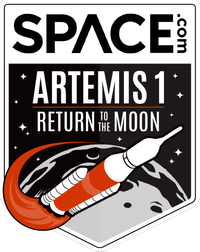Epic Artemis 1 moon rocket launch spotted streaking through Earth's atmosphere in satellite image
NASA's Artemis 1 launch to the moon streaks to space in a view from a weather satellite, which spotted the Space Launch System's water trail after liftoff Wednesday (Nov. 16).


That's one speedy streaker caught flying to space.
A weather satellite captured NASA's Artemis 1 mission in the moments after it lifted off for the moon on Wednesday (Nov. 16). Although the launch blasted off a pad in Florida at 1:47 a.m. EST (0647 GMT) in total darkness, the water plume of the Space Launch System was visible in the view of the GOES East satellite.
"You can see the rocket streaking through the atmosphere in this water vapor imagery," the National Oceanic and Atmospheric Administration (NOAA), which operates GOES East, said in a tweet.
GOES East's mid-level water vapor band is normally used for looking at winds in the lowest layer of the atmosphere, known as the troposphere, along with looking at jet streams, generating hurricane and storm motion predictions and estimating moisture, according to a NOAA backgrounder page.
Related: Artemis 1 launch photos: Amazing views of NASA's moon rocket debut (gallery)
.@NOAA's #GOESEast satellite captured the early morning launch of NASA's #Artemis I from @NASAKennedy in Florida! You can see the rocket streaking through the atmosphere in this water vapor imagery. https://t.co/8EN9KfWliM pic.twitter.com/lybvk01si4November 16, 2022
Artemis 1 has also been generating imagery from space on its own, with the first lower-resolution images beaming back already in the hours after launch. Parts of the Orion spacecraft are visible in these first-look views, along with the curve of the Earth in the background.
Images from ground, Earth's atmosphere and space will all be used in assessing the engineering success of Artemis 1. The flight is an uncrewed debut effort within NASA's larger Artemis program, which aims to put people on the moon in mid-decade at the earliest.
Breaking space news, the latest updates on rocket launches, skywatching events and more!
Next up, assuming Artemis 1 goes to plan, is the Artemis 2 crewed mission that will loop around the moon no earlier than 2024, and the Artemis 3 landing mission set so far for 2025 or 2026.
Elizabeth Howell is the co-author of "Why Am I Taller?" (ECW Press, 2022; with Canadian astronaut Dave Williams), a book about space medicine. Follow her on Twitter @howellspace. Follow us on Twitter @Spacedotcom or Facebook.

Elizabeth Howell (she/her), Ph.D., was a staff writer in the spaceflight channel between 2022 and 2024 specializing in Canadian space news. She was contributing writer for Space.com for 10 years from 2012 to 2024. Elizabeth's reporting includes multiple exclusives with the White House, leading world coverage about a lost-and-found space tomato on the International Space Station, witnessing five human spaceflight launches on two continents, flying parabolic, working inside a spacesuit, and participating in a simulated Mars mission. Her latest book, "Why Am I Taller?" (ECW Press, 2022) is co-written with astronaut Dave Williams.
